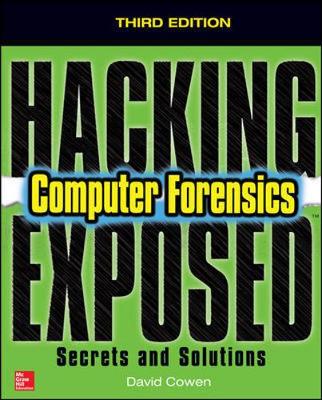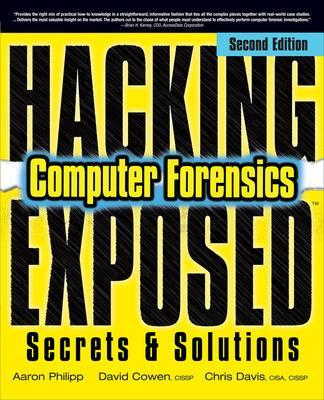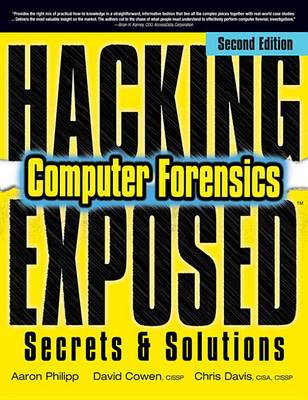Hacking Exposed
3 total works
Hacking Exposed Computer Forensics, Third Edition reveals how to identify and investigate computer crimes of all types, and explains how to construct a high-tech forensics lab, collect prosecutable evidence, discover email and system file clues, track wireless activity, and recover obscured documents. You'll learn how to recreate the path of the attacker, access a variety of devices, gather evidence, communicate with attorneys about their investigations, and prepare reports.
In addition to a top-down update of the content, the book features several all-new chapters on the topics of cloud forensics, malware analysis, and laws and regulations in the European Union. The Hacking Exposed brand is synonymous with practical get-the-job-done tips for security practitioners. Threats to information security are more virulent today than ever before-this new edition is an essential read for information security professionals who must successfully troubleshoot the newest, toughest digital forensics cases ever seen.
- Features three completely new chapters on cloud forensics, malware analysis, and laws and regulations in the European Union with information on data restrictions concerning international investigations
- Explains how to restore deleted documents, partitions, user activities, and file systems
- Details techniques for unlocking clues stored in mobile devices
- Covers how to analyze evidence gathered from Windows, Linux, and Mac systems
Hacking Exposed Computer Forensics, Second Edition
by Aaron Philipp, David Cowen, and Chris Davis
Publisher's Note: Products purchased from Third Party sellers are not guaranteed by the publisher for quality, authenticity, or access to any online entitlements included with the product.
The latest strategies for investigating cyber-crime
Identify and investigate computer criminals of all stripes with help from this fully updated. real-world resource. Hacking Exposed Computer Forensics, Second Edition explains how to construct a high-tech forensic lab, collect prosecutable evidence, discover e-mail and system file clues, track wireless activity, and recover obscured documents. Learn how to re-create an attacker's footsteps, communicate with counsel, prepare court-ready reports, and work through legal and organizational challenges. Case studies straight from today's headlines cover IP theft, mortgage fraud, employee misconduct, securities fraud, embezzlement, organized crime, and consumer fraud cases.
- Effectively uncover, capture, and prepare evidence for investigation
- Store and process collected data in a highly secure digital forensic lab
- Restore deleted documents, partitions, user activities, and file systems
- Analyze evidence gathered from Windows, Linux, and Macintosh systems
- Use the latest Web and client-based e-mail tools to extract relevant artifacts
- Overcome the hacker's anti-forensic, encryption, and obscurity techniques
- Unlock clues stored in cell phones, PDAs, and Windows Mobile devices
- Prepare legal documents that will hold up to judicial and defense scrutiny
Hacking Exposed Computer Forensics
by Chris Davis, David Cowen, and Aaron Philipp
"Provides the right mix of practical how-to knowledge in a straightforward, informative fashion that ties it all the complex pieces together with real-world case studies. ...Delivers the most valuable insight on the market. The authors cut to the chase of what people must understand to effectively perform computer forensic investigations." --Brian H. Karney, COO, AccessData Corporation
The latest strategies for investigating cyber-crime
Identify and investigate computer criminals of all stripes with help from this fully updated. real-world resource. Hacking Exposed Computer Forensics, Second Edition explains how to construct a high-tech forensic lab, collect prosecutable evidence, discover e-mail and system file clues, track wireless activity, and recover obscured documents. Learn how to re-create an attacker's footsteps, communicate with counsel, prepare court-ready reports, and work through legal and organizational challenges. Case studies straight from today's headlines cover IP theft, mortgage fraud, employee misconduct, securities fraud, embezzlement, organized crime, and consumer fraud cases.
- Effectively uncover, capture, and prepare evidence for investigation
- Store and process collected data in a highly secure digital forensic lab
- Restore deleted documents, partitions, user activities, and file systems
- Analyze evidence gathered from Windows, Linux, and Macintosh systems
- Use the latest Web and client-based e-mail tools to extract relevant artifacts
- Overcome the hacker's anti-forensic, encryption, and obscurity techniques
- Unlock clues stored in cell phones, PDAs, and Windows Mobile devices
- Prepare legal documents that will hold up to judicial and defense scrutiny


